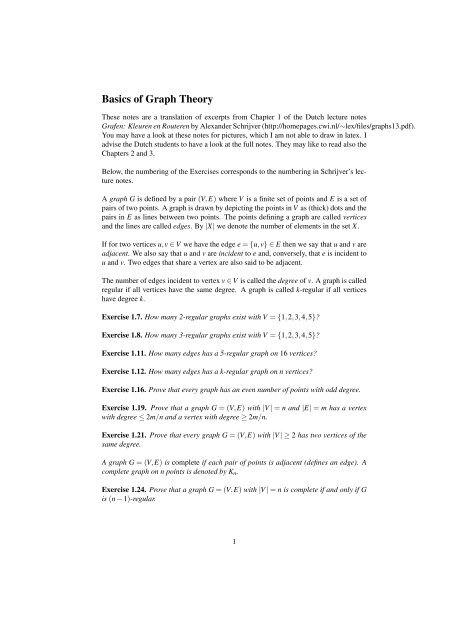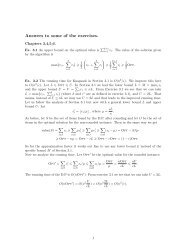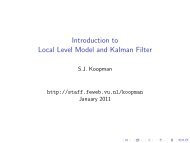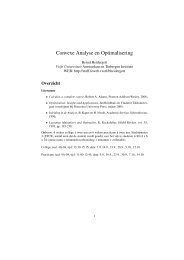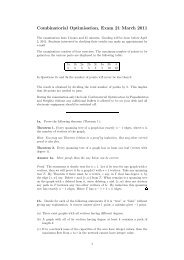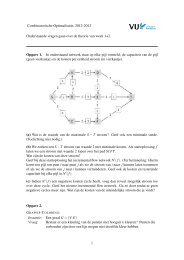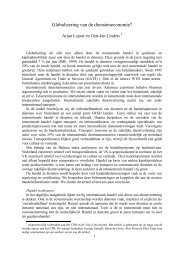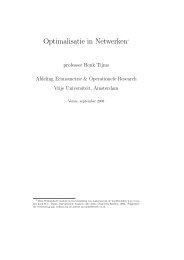Create successful ePaper yourself
Turn your PDF publications into a flip-book with our unique Google optimized e-Paper software.
<strong>Basics</strong> <strong>of</strong> <strong>Graph</strong> <strong>Theory</strong><br />
These notes are a translation <strong>of</strong> excerpts from Chapter 1 <strong>of</strong> the Dutch lecture notes<br />
Grafen: Kleuren en Routeren by Alexander Schrijver (http://homepages.cwi.nl/∼lex/files/graphs13.pdf).<br />
You may have a look at these notes for pictures, which I am not able to draw in latex. I<br />
advise the Dutch students to have a look at the full notes. They may like to read also the<br />
Chapters 2 and 3.<br />
Below, the numbering <strong>of</strong> the Exercises corresponds to the numbering in Schrijver’s lecture<br />
notes.<br />
A graph G is defined by a pair (V,E) where V is a finite set <strong>of</strong> points and E is a set <strong>of</strong><br />
pairs <strong>of</strong> two points. A graph is drawn by depicting the points in V as (thick) dots and the<br />
pairs in E as lines between two points. The points defining a graph are called vertices<br />
and the lines are called edges. By |X| we denote the number <strong>of</strong> elements in the set X.<br />
If for two vertices u,v ∈ V we have the edge e = {u,v} ∈ E then we say that u and v are<br />
adjacent. We also say that u and v are incident to e and, conversely, that e is incident to<br />
u and v. Two edges that share a vertex are also said to be adjacent.<br />
The number <strong>of</strong> edges incident to vertex v ∈ V is called the degree <strong>of</strong> v. A graph is called<br />
regular if all vertices have the same degree. A graph is called k-regular if all vertices<br />
have degree k.<br />
Exercise 1.7. How many 2-regular graphs exist with V = {1,2,3,4,5}?<br />
Exercise 1.8. How many 3-regular graphs exist with V = {1,2,3,4,5}?<br />
Exercise 1.11. How many edges has a 5-regular graph on 16 vertices?<br />
Exercise 1.12. How many edges has a k-regular graph on n vertices?<br />
Exercise 1.16. Prove that every graph has an even number <strong>of</strong> points with odd degree.<br />
Exercise 1.19. Prove that a graph G = (V,E) with |V | = n and |E| = m has a vertex<br />
with degree ≤ 2m/n and a vertex with degree ≥ 2m/n.<br />
Exercise 1.21. Prove that every graph G = (V,E) with |V | ≥ 2 has two vertices <strong>of</strong> the<br />
same degree.<br />
A graph G = (V,E) is complete if each pair <strong>of</strong> points is adjacent (defines an edge). A<br />
complete graph on n points is denoted by Kn.<br />
Exercise 1.24. Prove that a graph G = (V,E) with |V | = n is complete if and only if G<br />
is (n − 1)-regular.<br />
1
A graph G is bipartite if V can be split into two sets V1 and V2 such that for each<br />
edge e = {u,v} ∈ E, we have |e ∩V1| = |e ∩V2| = 1. A complete bipartite graph with<br />
V = V1 ∪V2 has edge set E = {{v1,v2} | v1 ∈ V1, v2 ∈ V2}. The complete bipartite graph<br />
with |V1| = m and |V2| = n is denoted by Km,n.<br />
Exercise 1.26. For which values <strong>of</strong> m and n is Km,n regular?<br />
A walk in a graph G = (V,E) is a sequence <strong>of</strong> vertices (v0,v1,...,vk) such that for all<br />
i = 1,...,k, {vi−1,vi} ∈ E. It is called a walk is from v0 to vk. We say that this walk has<br />
(combinatorial) length k. If all vertices on the walk are distinct we call it a path.<br />
Exercise 1.39. How many paths are there from vertex 1 to vertex 3 in K3?<br />
Exercise 1.42. How many paths are there from vertex 1 to vertex n in Kn?<br />
Exercise 1.43. Prove that if in a graph there exists a walk from vertex s to vertex t then<br />
there exists a path from s to t.<br />
Exercise 1.44. Prove that that a graph <strong>of</strong> which each vertex has degree at least k, has a<br />
path <strong>of</strong> length k.<br />
A graph is called connected if there is a path between any two <strong>of</strong> its vertices.<br />
Exercise 1.47. Prove that every connected graph on n vertices contains at least n − 1<br />
edges.<br />
Exercise 1.48. Does there exist a non-connected graph on 6 vertices containing 11<br />
edges.<br />
Exercise 1.50. Prove that every non-connected graph on n vertices contains at most<br />
(n − 1)(n − 2) edges.<br />
1<br />
2<br />
A graph G ′ = (V ′ ,E ′ ) is called a subgraph <strong>of</strong> G = (V,E) if V ′ ⊂ V and E ′ ⊂ E. A component<br />
<strong>of</strong> G = (V,E) is a maximal connected subgraph G ′ = (V ′ ,E ′ ): i.e., if there exists<br />
a connected subgraph ˆG <strong>of</strong> G such that G ′ is a subgraph <strong>of</strong> ˆG, then ˆG = G ′ . Hence, a<br />
graph G is connected if and only if it consists <strong>of</strong> exactly one component.<br />
Exercise 1.59. Prove that if G1 = (V1,E1) and G2 = (V2,E2) are two distinct components<br />
<strong>of</strong> G then V1 ∩V2 = /0.<br />
Exercise 1.61. Prove that if G1 = (V1,E1) and G2 = (V2,E2) are two distinct components<br />
<strong>of</strong> G then there exists no edge with one vertex in V1 and the other in V2.<br />
Exercise 1.62. Prove that there exists a path between u and v if and only if u and v<br />
belong to the same component.<br />
Exercise 1.63. Prove that a graph G = (V,E) with each vertex having degree at least<br />
(n − 1) is connected.<br />
1<br />
2<br />
2
Exercise 1.64. Prove that a graph G = (V,E) has at least |V | − |E| components.<br />
Exercise 1.65. Prove that a graph with exactly two vertices with odd degree must contain<br />
a path between these two vertices.<br />
A walk (v0,v1,...,vk) is called a closed walk or a cycle if v0 = vk. A cycle with all<br />
vertices distinct is called a circuit. A circuit <strong>of</strong> length 3 is called a triangle.<br />
Exercise 1.67. Prove that every graph with vertices that each have degree at least 2<br />
contains a circuit.<br />
G = (V,E) is called a forest if G does not contain any circuit. A connected forest is<br />
called a tree.<br />
Exercise 1.74. Prove that each component <strong>of</strong> a forest is a tree.<br />
Exercise 1.75. Prove that between any pair <strong>of</strong> vertices in a tree there is exactly one path.<br />
A vertex <strong>of</strong> degree 1 in a tree is called a leaf <strong>of</strong> the tree.<br />
Exercise 1.76. Prove that every tree with at least two vertices contains a leaf (cf. Exercise<br />
1.24).<br />
Exercise 1.77. Derive from the previous exercise that every tree on n vertices has exactly<br />
n − 1 edges.<br />
Exercise 1.78. Prove that every tree with exactly 2 leaves is a path.<br />
Exercise 1.79. Prove that a forest on n vertices consisting <strong>of</strong> k components contains<br />
exactly n − k edges.<br />
Exercise 1.80. Prove that every tree with at least two vertices contains at least two<br />
leaves.<br />
Exercise 1.81. Let G be a tree with a vertex <strong>of</strong> degree k. Prove that G contains at least<br />
k leaves.<br />
An Euler cycle in a graph G = (V,E) is a cycle C = (v0,v1,...,vk) (remember that<br />
v0 = vk), with the property that every edge e ∈ E is traversed exactly once; i.e., for each<br />
edge e ∈ E there exists exactly one i ∈ {1,...,k} such that e = {vi−1,vi}. A graph is<br />
called an Euler graph if it contains an Euler cycle.<br />
Theorem 1.1 (Euler’s Theorem). A graph G = (V,E) is an Euler graph if and only if<br />
G is connected and each <strong>of</strong> its vertices has even degree.<br />
3
Exercise. Prove Euler’s Theorem. Try this one before you read it in Schrijver’s lecture<br />
notes.<br />
Exercise 1.88. Let G be a connected graph with exactly two points <strong>of</strong> odd degree. Use<br />
Euler’s Theorem to prove that G contains a walk that traverses each edge exactly once.<br />
A circuit C <strong>of</strong> G is called a Hamilton circuit if each vertex <strong>of</strong> G appears on C. A graph<br />
G is called a Hamilton graph if it contains a Hamilton circuit.<br />
Exercise 1.90. Show that on a n × n chess-board a horse cannot make a tour visiting<br />
each field exactly once if n is odd.<br />
Exercise 1.91. Show that for each n there exists a graph on n vertices such that each<br />
vertex has degree at least 1 2n − 1 and such that it is not a Hamilton graph.<br />
There does not exist a good characterisation <strong>of</strong> Hamiltonian graphs comparable to Theorem<br />
1.1 for characterising Euler graphs. The next theorem only gives a sufficient condition.<br />
Theorem 1.2 (Dirac’s Theorem). Let G be graph on n ≥ 3 vertices, each <strong>of</strong> which has<br />
degree at least 1 2n. Then G is a Hamilton graph.<br />
PROOF. Suppose there exists as a counterexample a graph G on n vertices. Then there<br />
exists such a graph with a maximum number number <strong>of</strong> edges. So, G itself is not a<br />
Hamilton graph but if we add one edge to G than it becomes a Hamilton graph. Hence,<br />
there is a path<br />
P = (v1,...,vn)<br />
on which every vertex appears exactly once (a so-called Hamilton path. Because G is<br />
not a Hamilton graph, there is no edge between v1 and vn. Define<br />
I := {i | vi is adjacent to v1};<br />
J := {i | vi−1 is adjacent to vn}.<br />
Because v1 has degree at least 1 2n, |I| ≥ 1 2n. Similarly, |J| ≥ 1 2n. Because I,J ⊂<br />
{2,...,n}, we have I ∩ J = /0. Choose i ∈ I ∩ J. Thus, vi is adjacent to v1 and vi−1<br />
is adjacent to vn. Then<br />
(v1,vi,vi+1,...,vn,vi−1,vi−2,...,v2,v1)<br />
is a Hamilton circuit in G, contradicting our assumption. <br />
4


